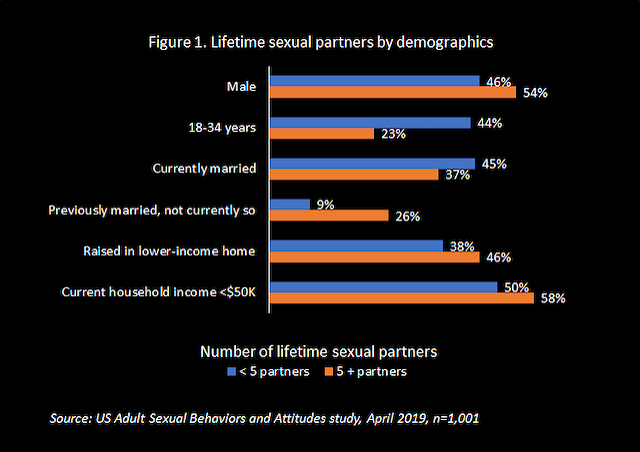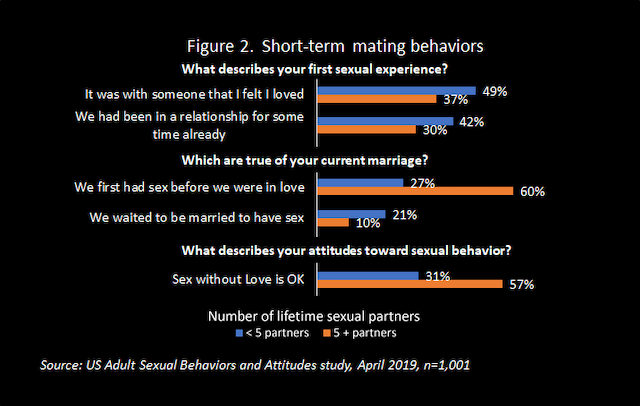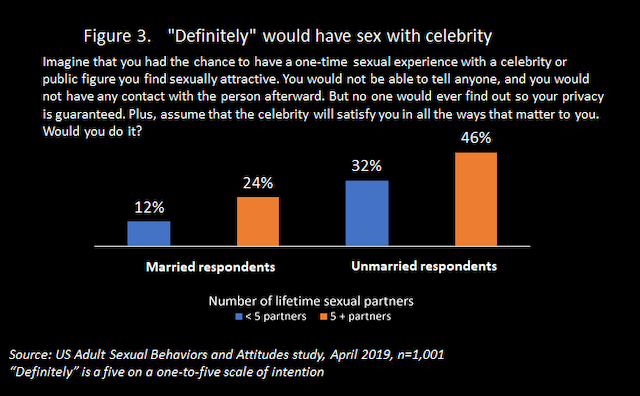Highlights
- For people who reported four or fewer lifetime sexual partners, the rate of infidelity in the current marriage dropped to 11%, while for those who had five or more sexual partners the number was nearly double (21%). Post This
- Starting with their first sexual experience, 49% of those with fewer partners said their first time was with someone that they loved, compared with 37% of those with more sex partners. Post This
The old joke starts with “How do you get to Carnegie Hall?” and ends with the sage words, “Practice, practice, practice.”
It is advice that appears to apply to people who want to engage in—or prevent—marital infidelity. People who are sexually unfaithful to their marriage partners “practice” behaviors going back to their very first sexual experiences that increase the likelihood that they will be unfaithful. Conversely, by avoiding those same behaviors, those who wish to remain faithful to their marriage partners can reduce the likelihood that they’ll be the source of marital infidelity.
We learn all this from a recent study of 1,001 US adults that I conducted in April of 2019, in which 500 men and 501 women were asked about their relationship behaviors, sexual practices, and attitudes toward a variety of relationship issues (for the details of this survey, please see the footnotes).1
Among the participants, 16% of married adults had committed sexual infidelity at least once in their current marriage (the study did not measure infidelities that occurred in prior marriages). And this finding is consistent with similar reports based on the General Social Survey. While many things contribute to one’s likelihood of having an extramarital affair, one of the strongest predictors is the number of lifetime sexual partners.
For people in this survey who reported four or fewer lifetime sexual partners, the rate of infidelity in the current marriage dropped to 11%, while for those who had five or more sexual partners the number was nearly double (21%). The break between the 54% of people who had five or more lifetime sexual partners vs. the 46% who had four or fewer total partners illustrates the lessons from the study. This breakpoint is validated by the fact that when asked straight out, 68% of those with more sexual partners in their pasts agreed that, “I am always faithful to my sexual partner” (whether currently married or single), compared to 82% of those with fewer sexual partners who said the same.
My study also examined factors that predict the tendency to have multiple lifetime sexual partners. Some obvious demographics emerge, as shown in Figure 1.

First, those who report having five or more sexual partners are more likely to be male. Younger people have had less time to experience multiple relationships, so it makes sense that 44% of those with fewer sexual partners are under 35 years of age, versus 23% of those with more sexual partners. Those who reported fewer partners were more likely to be married, while those with more partners were more likely to be previously married but currently single. Growing up in a lower-income home and currently having a lower household income also contributed to the increased number of sexual partners.
Beyond these contributors, some key practices consistent with what researchers call a short-term mating strategy also factor in as shown in Figure 2 below.2 Starting with their first sexual experience, 49% of those with fewer partners said their first time was with someone that they loved, compared with 37% of those with more sex partners. Similarly, 42% of those with fewer partners reported that their first time was in the context of an extended relationship. The number is just 30% for those who have had more partners.

Among those who are married, just 27% of those with fewer partners said they had sex with their now-spouse before they were in love. That compares with 60% for those with more sexual partners. Most telling, for their current marriage, 21% of those with fewer sexual partners said they waited for their wedding day to be intimate with each other, twice as many as those who had more lifetime sexual partners. None of this is surprising when we consider that 57% of those with more sexual partners agreed that “Sex without love is OK,” nearly twice the rate for those who reported fewer partners.
These short-term mating behaviors and attitudes are a type of practice that prepares one for future sexual variety. But this practice can extend into fantasy as well.
Consider pornography: for those with fewer sexual partners, 45% reported not looking at porn compared to 31% of those with more sexual partners. This practicing for sexual variety and possibly infidelity goes even into the hypothetical. When offered a chance to have a risk-free sexual encounter with a celebrity they find sexually attractive—and when assured that it would be a sexually satisfying experience—31% of all adults in the survey said they would “definitely” do it, by marking 5 on a 1-to-5 scale. Because this response should differ by whether someone is currently married or not, we broke respondents out by whether they were currently married as well by their number of lifetime sexual partners. The results in Figure 3 capture the tendency to mentally practice infidelity.

The least likely to say they would definitely sleep with their fantasy celebrity are those with fewer sexual partners and those who are currently married. Twice as likely to jump at the chance are those with more sexual partners who are also currently married. Even though they are currently unmarried, just 32% of singles with fewer sexual partners said they would take the risk-free sexual encounter with a celebrity, preferring instead to practice fidelity at a higher rate than the 46% of singles with five or more lifetime sexual partners who would definitely seize the night, as it were.
Of course, this hypothetical example is not a cause of infidelity. Instead, as my survey results illustrate, infidelity’s roots likely start much earlier in someone’s background and experience.3 But infidelity is also often the fruit of a lifelong approach to mating that involves seeking and practicing short-term mating encounters that encourage sexual variety at all stages and into marriage.
How do you get to infidelity? Practice, practice, practice.
James L. McQuivey (Ph.D., Syracuse University) has taught at Boston University and Syracuse University. He is a consumer behaviorist and analyst who is regularly sought for commentary by publications like The New York Times and The Wall Street Journal. His research into family studies focuses on human mating strategies and the role of parents in determining positive life outcomes. He is the author of the book Why We Need Dad. Follow him on Twitter @jmcquivey.
Editor's Note: The opinions expressed in this article are those of the authors and do not necessarily reflect the official policy or views of the Institute for Family Studies.
1. In April 2019, a survey of U.S. Adult Sexual Behaviors and Attitudes was fielded to a nationally representative sample of adults ranging in age from 18 to 74. The outgoing sample was balanced by sex, age cohort, and U.S. Census region. Sample sourced from and data collection provided by Dynata, a global leader in first-party data and data services. The respondents were weighted back to the outgoing sample parameters for sex, age, and region. Data were validated for internal consistency and compared for population representation to US Census data and GSS data for income, rates of marriage, and childbearing. The project was conceived, designed, executed, and paid for entirely by Dr. James McQuivey.
2. Men are more likely to prefer short-term mating behaviors than women, including a preference for more sexual partners over time. See, “Are men really more oriented toward short-term mating than women? A critical review of theory and research,” Psychology, Evolution and Gender, 3 no. 3 (2001).
3. Research into adolescent sexual behavior shows that household composition, such as whether someone was raised by two biological parents, contributes to attitudes toward and experiences with sexual experimentation, correlating with having multiple sexual partners into early adulthood. The data from the present study, though not reported here, support these findings. See, “Ten years of longitudinal research on U.S. adolescent sexual behavior,” Developmental Review, 28, no. 2 (2008).











